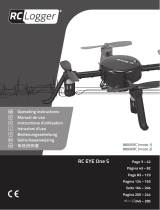
6
EN
First Flight Preparation
• Remove and inspect contents
• Begin charging the fl ight battery
• Install the fl ight battery in the quadcopter
(once it has been fully charged)
• Program your computer transmitter
• Bind your transmitter
• Familiarize yourself with the controls
• Find a suitable area for fl ying
Flying Checklist
❏ Always turn the transmitter on fi rst
❏ Plug the fl ight battery into the lead from the
4-in-1 control unit
❏ Allow the 4-in-1 control unit to initialize and
arm properly
❏ Fly the model
❏ Land the model
❏ Unplug the fl ight battery from the 4-in-1
control unit
❏ Always turn the transmitter off last
The battery chargers (EFLC1008 and FSV1802) included
with your quadcopter have been designed to safely charge
the Li-Po batteries.
CAUTION: All instructions and warnings must be
followed exactly. Mishandling of Li-Po batter-
ies can result in a fi re, personal injury and/or property
damage.
• By handling, charging or using the included Li-Po
battery, you assume all risks associated with lithium
batteries.
• If at any time the battery begins to balloon or swell,
discontinue use immediately. If charging or discharging,
discontinue and disconnect. Continuing to use, charge
or discharge a battery that is ballooning or swelling can
result in fi re.
• Always store the battery at room temperature in a dry
area for best results.
• Always transport or temporarily store the battery in a
temperature range of 40–120º F (5–49° C). Do not store
battery or model in a car or direct sunlight. If stored in a
hot car, the battery can be damaged or even catch fi re.
• Always charge batteries away from fl ammable
materials.
• Always inspect the battery before charging.
• Always disconnect the battery after charging, and
let the charger cool between charges.
• Always constantly monitor the temperature of the
battery pack while charging.
• ONLY USE A CHARGER SPECIFICALLY DESIGNED TO
CHARGE LI-PO BATTERIES. Failure to charge the battery
with a compatible charger may cause a fi re resulting in
personal injury and/or property damage.
• Never discharge Li-Po cells to below 3V under load.
• Never cover warning labels with hook and loop strips.
• Never leave charging batteries unattended.
• Never charge batteries outside recommended levels.
• Never charge damaged batteries.
• Never attempt to dismantle or alter the charger.
• Never allow minors to charge battery packs.
• Never charge batteries in extremely hot or cold places
(recommended between 40–120° F (5–49° C) or place in
direct sunlight.
Charging Warnings





















